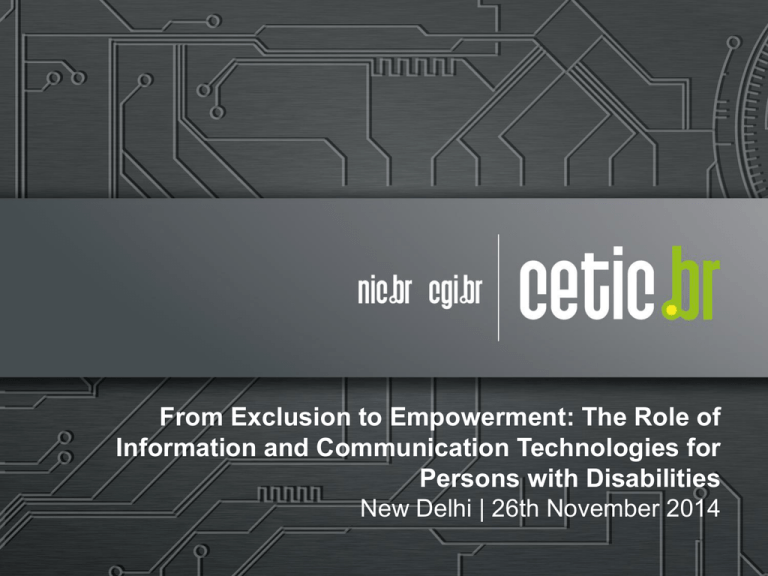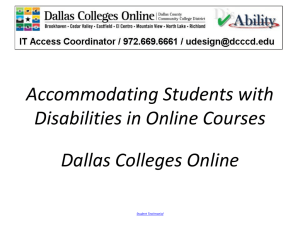maria_eugenia_sozio_session_13
advertisement

From Exclusion to Empowerment: The Role of Information and Communication Technologies for Persons with Disabilities New Delhi | 26th November 2014 SESSION 13 Methods of Data Collection on ICT and Persons with Disabilities in Brazil About CETIC UNESCO (*) Regional Center of Studies for the Development of the Information Society CETIC.br Brazilian Internet Brazilian Network Steering Committee Information Center 1995 Latin Latin America and America andPortuguese Portuguese speaking African countries countries speaking African 2005 2012 Regional Center for Studies on the Development of the Information Society Produce ICT indicators and statistics Promote the use of ICT statistics for policymaking and academic research Monitor socioeconomic impacts Monitoring socioeconomic implications of ICTs ICT surveys in Brazil Internationally agreed methodological frameworks Monitoring targets Data on disabilities in Brazil Existing statistics General population General population 10 years or older and Internet users Data on disabilities in Brazil IBGE Census 2010 IBGE Census 2010 included indicators on four types of disabilities related to seeing, hearing, walking and mental/intellectual. Questions covered the difficulty to perform daily activities and the level of such difficulty, in compliance to the Census Questions on Disabilities endorsed by the Washington Group on Disabilities Statistics. QUESTION: Do you have permanent difficulty seeing? (even if wearing glasses) 1. Yes – can’t see at all 2. Yes – a lot of difficulty 3. Yes – some difficulty 4. No – no difficulty Person with severe disability Person with disability Data on disabilities in Brazil IBGE Census 2010 Brazilian population: 23,9% had at least one type of disability (45,6 MM): The most prevalent difficulty was seeing (18,6%), followed by walking (7%), hearing (5,1%) and mental or intellectual (1,4%). Considering severe levels of disabilities: 8,3% of the population had at least one of the surveyed disabilities in 2010. The most prevalent severe disability was related to seeing (3,46%). Gender, age and geographical region: Women reported disabilities more than men (26,5% versus 21,2%). 67,7% of the population aged 65 years old or older reported some type of disability in any level, while 41,8% reported a severe level of disability. Northeast region had the highest proportion of the population reporting disabilities (26,6%). Data on disabilities in Brazil Mixed mode of data collection Statistics on: Persons with disabilities ICT and persons with disabilities Web accessibility Probability Sample Survey Statistics on: Web accessibility Automated Data Collection Qualitative data: Focus group and indepth interviews with persons with disabilities Qualitative Research ICT and persons with disabilities Methods of data collection Mixed modes of data collection on persons with disabilities and the use of ICTs Approach Data collection method Project Quantitative Nationwide annual sample survey ICT Household Survey Automated data Use of web crawler collection tool Qualitative Focus-groups and in-depth interviews “.gov.br” Web Census Web Accessibility study ICT Households Survey Sociodemographic variables CETIC.br’s ICT Households Survey has been collecting data regarding each member of the household since 2006. Three ICT related indicators are: Use of Computer in the household in the last 3 months; Use of Internet in the household in the last 3 months; Ownership of a mobile phone; ICT related indicators Members of the household ICT Households Survey Data collection on disabilities (since 2010) Measuring disabilities by proxy related to limitations in basic activity functioning: Seeing IBGE Census Hearing Walking Washington Group on Disability Statistics Mental/Intellectual Hands movement Based on questions adapted from IBGE Census Relevant for the use of ICTs Difficulties in firmly holding items such as cutlery or a pen. This was aimed at classifying persons with physical disabilities related to the upper body, such as hands and arms “gov.br” Web Census Project Context and scope “The most valuable contribution of the Web is social” “More important than its technological dimension, is that it is an environment for human communication, commercial transactions, government relations and sharing knowledge” Web Crawler Data Analyzer “gov.br” Web Census Project Key concepts for the automated data collection website1.gov.br website2.gov.br website3.gov.br website4.gov.br ... websiten.gov.br WEB Content search (text only) Web Crawler and Analysis Tools Extraction of new URLs new URL1 new URL2 new URL3 ... Analysis & Reports Database “gov.br” Web Census Project Category of indicators A1: Overall size of the “.gov.br": nr. of Websites and pages B1: Proportion of Websites using IPv6 Protocol Accessibility A2: Overall size of the “.gov.br”: size in Gigabytes C1: Distribution of use of languages in the “.gov.br” Web E1: Proportion of Web pages compliant with W3C HTLM standards F1: Proportion of Web pages compliant with ASES accessibility standards B2: Proportion of Websites using alternative IPv6 domain G1: Proportion of type of objects used in Web pages B3: Proportion of Websites which respond to Ping IPv6 G2: Proportion of types of technologies used in Web pages B4: Proportion of Websites which respond to GET command at the IPv6 address H1: Average age (last updated) of “.gov.br” Web pages Compliance with W3C HTML standards Proportion of websites compliant with standards Status of Validation 2010 2011 Validated 5,02% 6,38% Non validated 90,74% 86,45% Impossible to validate 4,24% 7,17% Pages often had less than 10 errors (37,27%), but there was a large proportion that had more than 100 errors (14,17%) during the validation process. This data suggests that the majority of the pages are not far from being compliant with the standards. Compliance with Priority Levels - ASES Proportion of websites compliant with standards Status of Validation 2010 2011 Non Compliance 98,00% 95,18% Priority 1 (A) 1,14% 3,71% Priority 2 (AA) 0,23% 0,13% Priority 3 (AAA) 0,63% 0,98% The analysis on accessibility reveals that there is much that can be done to improve Web accessibility at the “.gov.br” web pages. Only 4,82% of the webpages were compliant with any of the levels of accessibility (“A”, “AA” or “AAA”). Measuring Web accessibility Qualitative approach Concepts of Web Accessibility and Universal Design Qualitative data to complement quantitative sample survey Expert group on ICT and Accessibility Measuring Web accessibility Qualitative approach Aimed at conducting an exploratory study on Web accessibility; Internet use: benefits and barriers o Location of Internet access o Frequency of use o ICT skills o Online activities: communication, leisure, education, banking, e-government, e-commerce o General issues on browsing the Internet o Assistive technologies Measuring Web accessibility Qualitative techniques for data collection QUALITATIVE APPROACH PROFILE Focus Group Children without disabilities 7-9 y.o. SES “B & C” Internet users Focus Group Adults without disabilities 30 y.o.+ SES “B & C” Internet users Focus Group Persons that are blind Persons with physical Focus Group disabilities (upper body) Persons with low In-depth Interview vision In-depth Interview Persons that are deaf Internet users Internet users Internet users Internet users Measuring Web accessibility Respondent’s voice "It's horrible, is the most polluted site on earth, I cannot find anything. The site has more information than you need.“ [Adult, Internet user] "The other day I went online to buy tickets to the movies, because you can book your seat. But for you to select the seat, you must click on a tiny dot.“ [Adult, Internet user, person with physical disability] "Oh, at first I didn’t have much patience to listen to software. It was too much talking. But then we got along when I started to search for recipes online.” [Adult, Internet user, person that is blind] "If I click here and do something wrong, will everyone see?” [Adult, Internet user] "I go to the window that says “GOG –” something. Then I write, Barbie games and they appear. My cousin taught me.“ [Children, Internet user] Data and statistics for Evidence-based policymaking “The impact of policy can be measured with good statistics. If policy cannot be measured it is not good policy.” (Othman, 2005) PRODUCTION OF INDICATORS AND STATISTICS o Reliable o Policy relevant o Timely (to inform policy decisions) o Accessible to all key stakeholders o Cost-effective o Interdisciplinary enough to address cross-cutting issues ICT Statistics and Indicators Internationally comparable data Policy-relevant data analysis Policy making o Empowering and inclusive policies Thank you www.cetic.br msozio@nic.br @ComuNICbr Facebook.com/nic.br





